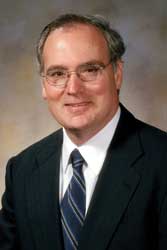 With the fast-growing Asia-Pacific region gaining in importance every day, both for propulsion OEMs and servicing organisations, Pratt & Whitney’s Steve Heath, president, commercial engines, talked recently to Flight Daily News about the company’s business in the region and the company’s ambitions for the future.
With the fast-growing Asia-Pacific region gaining in importance every day, both for propulsion OEMs and servicing organisations, Pratt & Whitney’s Steve Heath, president, commercial engines, talked recently to Flight Daily News about the company’s business in the region and the company’s ambitions for the future.
How important is Asian Aerospace 2006 for P&W?
Well, I’m sure that it’s important for all the propulsion OEMs and service organisations – but at P&W we are particularly conscious of the region and the fact that China is now becoming such a key part of our business. We have recently signed a memorandum of understanding [MoU] with China Eastern to establish a world-class engine overhaul shop – in Shanghai - for CFM56 engines, which power the Boeing 737 and Airbus A320. The overhaul shop’s repair capabilities, test cell and state-of-the-art information technology system will provide maintenance, repair and overhaul services to airline customers in China and the Asia-Pacific region, starting in 2007.
And this is a new part of your recently rebranded Global Service Partners organisation?
The new shop will indeed form part of our Global Service Partners organisation. GSP now has more than 500 aviation customers globally, served by a worldwide network of 24 overhaul and repair facilities capable of servicing all Pratt & Whitney engines, as well as IAE’s V2500 and the CFM56. In addition to overhaul and repair services, we provide on-wing repair services, engine monitoring and diagnostics, engine lease programmes and custom engine service programmes.
Is this your first servicing presence in China?
Yes it is, although P&W have been making engine parts in China for some years. With this JV, we are looking ahead 40 years or more and we are thrilled to be partnering China Eastern Airlines, which is not only a prominent airline in the region - with tremendous growth momentum - but it also has a quality service culture.
How have you found doing business in China?
Well, doing business in China is not always as straightforward as it can be elsewhere in the world, but it’s a low-cost country in which to operate and I’m sure that we will continue to expand our presence in such an important marketplace.
How do you see the 150-passenger segment – in which P&W has most interest - developing in China over the coming years?
Well, currently, there’s a backlog of orders of existing airframes and both P&W and IAE, in which we have a substantial shareholding, are hugely interested in how things develop in China. Will the successor to the 737 and the A320 be an indigenous airframe or maybe one produced with help from Boeing or Airbus? Whatever happens, both P&W and IAE will be involved, one way or the other. The technology is well identified and lined-up and validation is in place. Assuming that the new airframe has an entry-into-service date around 2012-13, then we will work with IAE to establish the route to market.
Tell us about the technology that you anticipate on any new engine for the 150-passenger segment?
Well, all I can say for sure is that it will feature a geared turbo fan [GTF] architecture to deliver improved fuel burn, lower emissions, greater environmental friendliness and more economical operation. We see huge demand for a GTF solution across the entire Asia-Pacific region.
What else are you focusing on at Asian Aerospace 2006?
Our JV with Singapore Airlines – Eagle Services Asia – is hugely important to us and is our largest-volume shop worldwide. We currently service around 10 engines a month – for Singapore Airlines and other regional companies – and we anticipate that several other organisations will be interested in learning more about this facility during the show.
Any other regional developments?
Well, although P&W is not directly represented on the 787, 747 advanced or the A350, the 767 line is still open and there is some potential for the freighter version of the A330-200/300. Our engines have the lowest operating costs on the A330 and the 4/68 upgrade offers a 1% improvement in fuel burn and an improvement of 20% in overall operating costs. Our “Advantage ’08” programme – due to be certificated in the 2008 timeframe – will offer core improvements designed to offer a “time on wing” improvement of around a further 10%.
But you do have some involvement, along with GE in the Engine Alliance JV, in one of the two engine options on the Airbus A380?
Indeed we do, and this engine is proving to be better than expectations – and specification - in just about every way. It received its final US Federal Aviation Administration certification right at the end of 2005 and I can say that the engine is performing extremely well. Indeed, it has required the smallest number of “class 1” engineering modifications, during the development phase, of any engine I can remember. Although we’re disappointed that we lost the China Southern order to R-R, we’re more hopeful about the UPS announcement – due in late spring this year. There are also rumours in the industry that Singapore Airlines may order between five and eight additional A380s…so watch this space!
Finally, what proportion of P&W’s income is now derived from your servicing business?
Although P&W’s OEM business represents only around 40% of our revenue, it is still by far the most important part of our business as we don’t sell new spares with old engines!
Source: Flight Daily News























